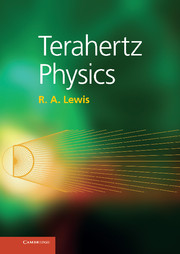7 - SOURCES
from Part II - Components
Published online by Cambridge University Press: 05 July 2013
Summary
This chapter employs trigonometry, differentiation, integration and vector algebra.
Electromagnetic radiation is produced
• by hot objects,
• by electric charges moving freely,
• by transitions between defined energy levels.
In Chapter 4, I discussed in detail the radiation given off by hot objects. Heat any object, and it will give off light. Thermal sources are perhaps the simplest and best-known sources of light. The sun radiates light because it is hot. Likewise the stars. The moon reflects the light of the sun. The embers of the fire glow because they are hot. Terahertz radiation is produced by thermal sources, but this will not be discussed in detail in this chapter; see Chapter 4 for further information.
An electromagnetic wave may be produced by ‘waving’, or appropriately moving, an electric charge, or charges. The principles behind the production of electromagnetic radiation by moving electric charges are set out in Section 7.2. The synchrotron and the free electron laser are two sources of terahertz-frequency electromagnetic radiation based on these principles.
Transitions between defined energy levels are the basis of the laser. The principles behind this are set out in Section 7.3. These principles inform the operation of the Gelaser, the quantum cascade laser and the molecular laser, which all operate at terahertz frequencies. Moreover, many additional schemes for terahertz generation are based on using visible or near-infrared lasers, either operating in the continuous mode, or operating in the pulsed mode.
- Type
- Chapter
- Information
- Terahertz Physics , pp. 127 - 161Publisher: Cambridge University PressPrint publication year: 2013

